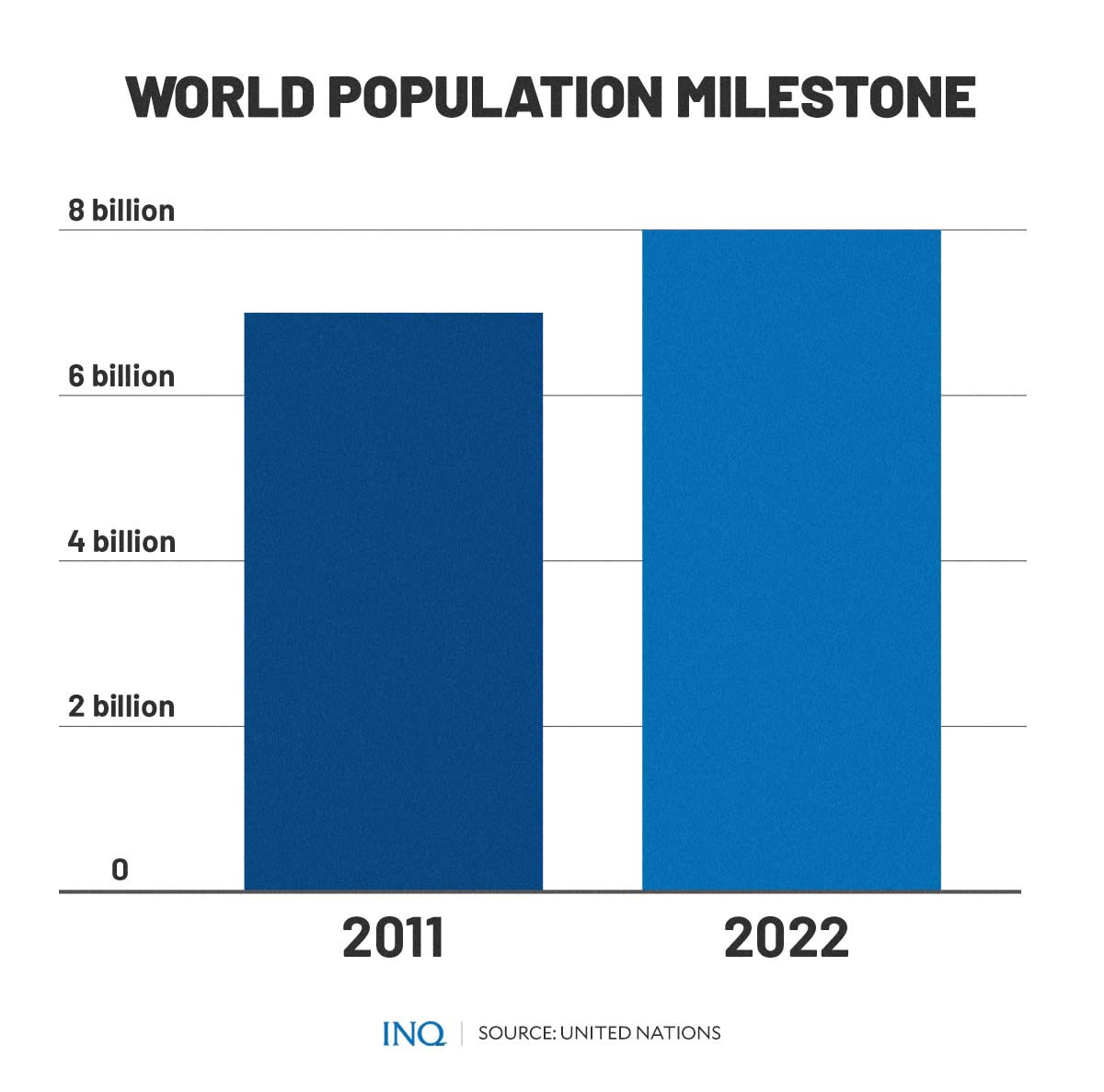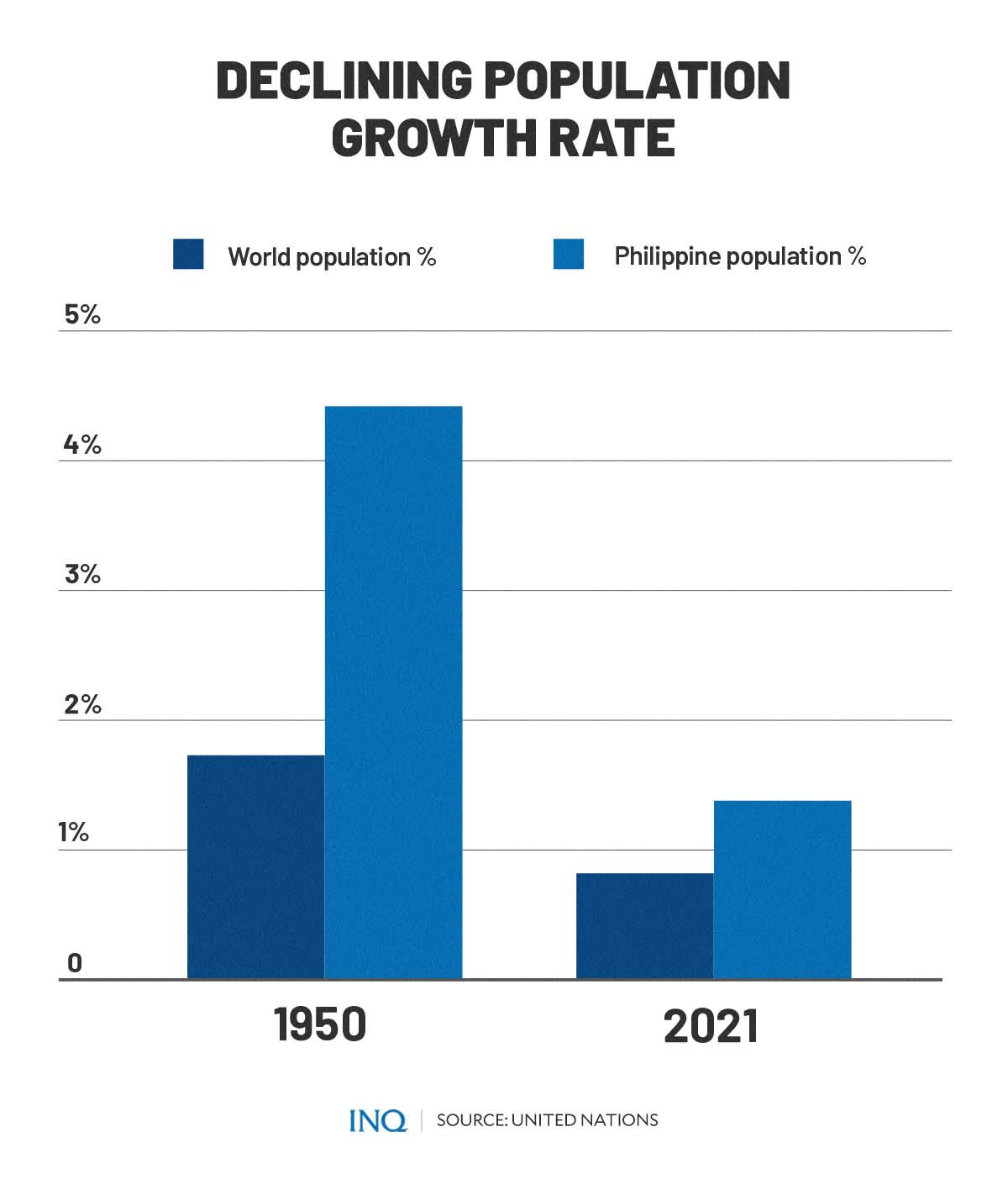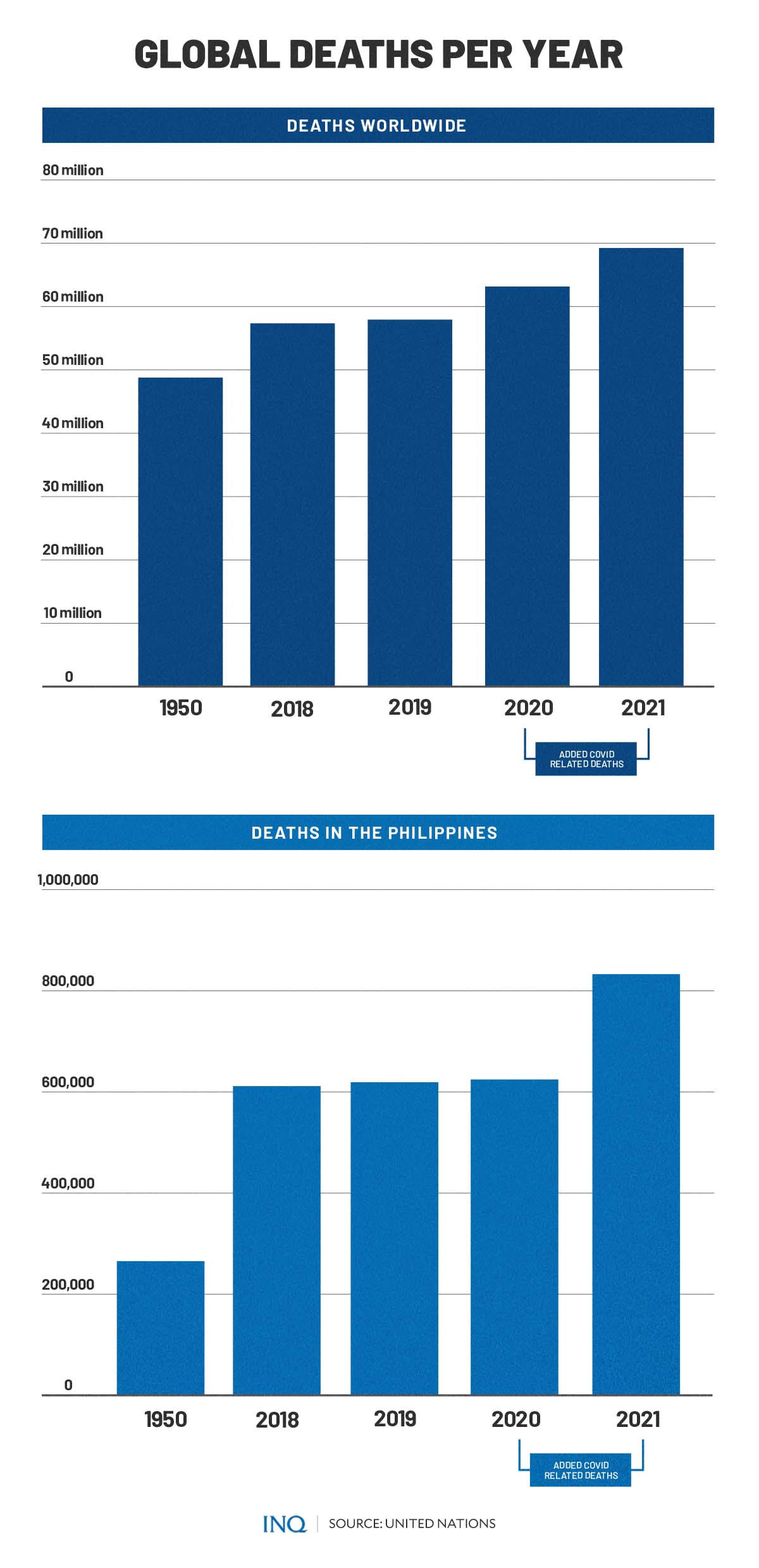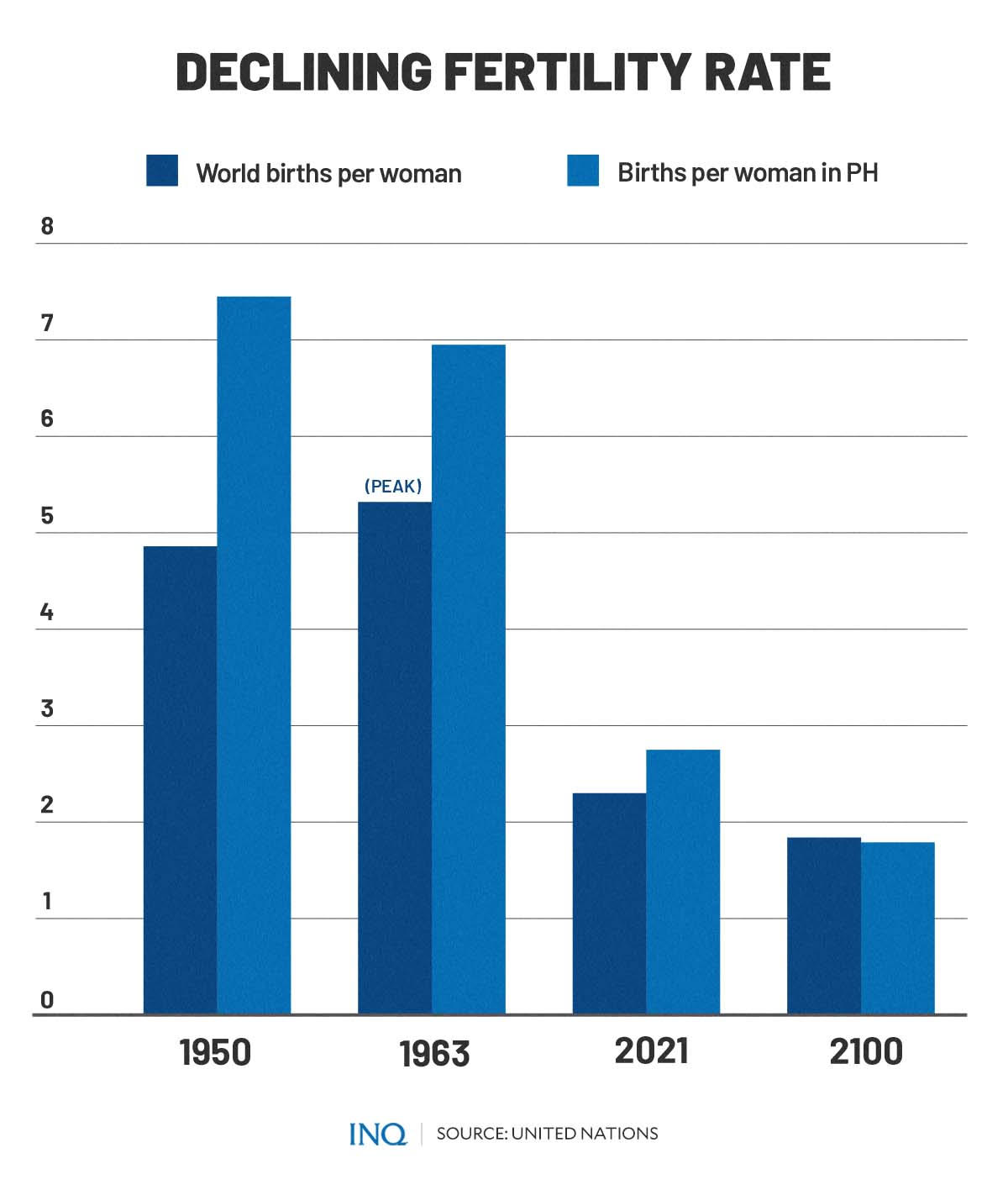World population: 8B by end 2022 despite COVID deaths, falling birth rates
MANILA, Philippines—On July 11, as countries across the globe observed World Population Day, the United Nations (UN) said that the world population will reach over 8 billion by the end of the year.
In the latest World Population Prospects report, the UN predicted that the global population will reach 8 billion on November 15 this year.
The last world population milestone was recorded in 2011 when the global population grew to 7 billion.
The UN predicted that the world’s population will further grow to around 8.5 billion in 2030, and 9.7 billion in 2050, “before reaching a peak of around 10.4 billion people during the 2080s.”
“The population is expected to remain at that level until 2100,” the UN said.
However, the UN noted that factors such as the declining global fertility rate and the COVID-19 pandemic will impact the growth of the global population.
Slowest growth rate since 1950
Population growth, the UN explained, is caused in part by declining levels of mortality, which is reflected in increased levels of life expectancy.
In 2019, life expectancy reached 77.28 years—an increase of almost 9 years since 1990. The UN said further reductions in mortality are expected to result in average longevity of around 77.2 years globally by the year 2050.
However, amid the projected global population growth rate, the UN stated that the world’s population is growing at its slowest rate since 1950.
“Over the one hundred years from 1950 to 2050, the world population was growing the fastest in the period 1962-1965, when it was increasing on average by 2.1 percent per year,” the UN said.
“Since then, the pace of population growth has slowed by more than half owing to reduced levels of fertility. In 2020, and for the first time since 1950, the rate of population growth fell below 1 percent per year, and it is projected to continue to slow in the next few decades and through the end of this century,” it added.
Based on the UN data, the population growth rate was at 1.73 percent in 1950, and it slowed down to 0.82 percent in 2021.
In the Philippines, from 4.42 percent in 1950, the country’s population growth rate slowed down to 1.38 percent last year.
Fertility rate drops further
“Following a drop in mortality, population growth continues so long as fertility remains at high levels. When fertility begins to fall, the annual rate of growth starts to drop,” the UN said.
The fertility rate, however, has fallen markedly in recent decades across the globe.
Last year, the average fertility of the world’s population stood at 2.3 births per woman over a lifetime. This was already lower compared to 4.86 or 5 births per woman in 1950. The figures are expected to decline further to 2.1 births per woman.
In the Philippines, numbers also showed that the average fertility rate will continue to decline among Filipino women.
In 1950, the average fertility rate in the country was 7.45 births per woman. Last year, the figures dropped to 2.75 births per woman. By the year 2100, the average fertility rate would be 1.79 births per Filipino woman.
Due to sustained low levels of fertility rates, the populations of 61 countries or areas are projected to decrease by 1 percent or more between 2022 and 2050.
“Among countries with at least half a million people, the largest relative reductions in population size until 2050, with losses of 20 percent or more, are expected to occur in Bulgaria, Latvia, Lithuania, Serbia, and Ukraine,” the UN stated.
Where population growth is concentrated
While populations in over 60 countries were seen to decrease due to continuously low fertility rate and also due to migration, over half of the projected increase in the global population between 2022 and 2050 is expected to be concentrated in just eight countries, including:
The Democratic Republic of Congo
- Egypt
- Ethiopia
- India
- Nigeria
- Pakistan
- The Philippines
- The United Republic of Tanzania
“The populations of the Democratic Republic of the Congo and the United Republic of Tanzania are expected to grow rapidly, between 2 and 3 percent per year over the 2022-2050 period,” said the UN.
The UN data also noted that there might be changes in the ranking of the world’s largest countries as population growth vary among different countries.
For instance, the ranking for the world’s ten most populous countries in 1990 and 2022 will look like this:
- China (1,144 billion) → China (1,426 billion)
- India (861 million) → India (1,412 billion)
- United States of America (246 million) → United States of America (337 million)
- Indonesia (181 million) → Indonesia (275 million)
- Brazil (149 million) → Pakistan (234 million)
- Russian Federation (148 million) → Nigeria (216 million)
- Japan (123 million) → Brazil (215 million)
- Pakistan (114 million) → Bangladesh (170 million)
- Bangladesh (106 million) → Russian Federation (145 million)
- Nigeria (94 million) → Mexico (127 million)
One of the biggest shifts in the ranking, however, is expected to occur in 2050 as India takes over China as the world’s most populous country.
Countries included in the top ten most populous in 2022 are also expected to either maintain their ranking or rise or fall on the list.
The projected ten most populous countries in the world in 2050—compared to the 2022 list—would look like this:
- China (1,426 billion) → India (1,668 billion)
- India (1,412 billion) → China (1,317 billion)
- United States of America (337 million) → United States of America (375 million)
- Indonesia (275 million) → Nigeria (375 million)
- Pakistan (234 million) → Pakistan (366 million)
- Nigeria (216 million) → Indonesia (317 million)
- Brazil (215 million) → Brazil (231 million)
- Bangladesh (170 million) → the Democratic Republic of the Congo (215 million)
- Russian Federation (145 million) → Ethiopia (213 million)
- Mexico (127 million) → Bangladesh (204 million)
Impact of COVID-19
The COVID-19 pandemic has also had a significant impact on the global population and migration trends.
“We know that the confirmed death toll from COVID-19 is likely to significantly underestimate the true number of deaths because of limited testing,” said Hannah Ritchie, senior researcher and head of research at Our World In Data.
“One way to get a better estimate of the total mortality impact of the pandemic is to look at excess mortality data. We can look at the total number of deaths and compare this to the number we expect to occur in a non-pandemic year.”
The UN’s latest estimates showed that in 2020, there were around 5 million excess deaths globally. The figures ballooned to 10 million last year, bringing the excess deaths over the past two years to 15 million.
Estimates from other organizations likewise presented nearly the same figures.
The Economist estimated that the excess deaths over 2020 and 2021 or during the pandemic were 17.6 million.
Meanwhile, the World Health Organization (WHO), a UN organization, recently estimated that there have been 14.9 million excess deaths “associated directly or indirectly with the COVID-19 pandemic” during the same period.
“These sobering data not only point to the impact of the pandemic but also to the need for all countries to invest in more resilient health systems that can sustain essential health services during crises, including stronger health information systems,” said Dr. Tedros Adhanom Ghebreyesus, WHO Director-General.
“WHO is committed to working with all countries to strengthen their health information systems to generate better data for better decisions and better outcomes.”
According to data from WHO, 84 percent of the excess deaths were concentrated in Southeast Asia, Europe, and the Americas, while around 68 percent of excess deaths were concentrated in just 10 countries globally.
Middle-income countries account for 81 percent of the 14.9 million excess deaths—53 percent in lower-middle-income countries and 28 percent in upper-middle-income countries—over the 24-month period.
“Measurement of excess mortality is an essential component to understand the impact of the pandemic. Shifts in mortality trends provide decision-makers information to guide policies to reduce mortality and effectively prevent future crises. Because of limited investments in data systems in many countries, the true extent of excess mortality often remains hidden,” said Dr. Samira Asma, Assistant Director-General for Data, Analytics and Delivery at WHO.
“These new estimates use the best available data and have been produced using a robust methodology and a completely transparent approach.”
“The United Nations system is working together to deliver an authoritative assessment of the global toll of lives lost from the pandemic. This work is an important part of UN DESA’s (Department of Economic and Social Affairs) ongoing collaboration with WHO and other partners to improve global mortality estimates,” said Liu Zhenmin, United Nations Under-Secretary-General for Economic and Social Affairs.




